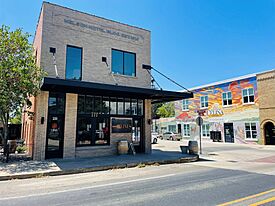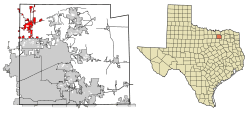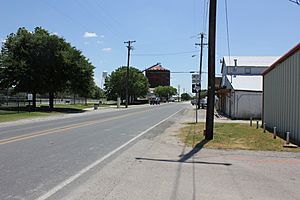Celina, Texas facts for kids
Quick facts for kids
Celina, Texas
|
|
|---|---|

Downtown Celina
|
|

Location of Celina in Collin County, Texas
|
|
| Country | United States |
| State | Texas |
| County | Collin, Denton |
| Established | 1876 |
| Founded | October 1879 |
| Incorporated | 1907 |
| Named for | Celina, Tennessee |
| Area | |
| • Total | 48.216 sq mi (124.879 km2) |
| • Land | 47.725 sq mi (123.607 km2) |
| • Water | 0.491 sq mi (1.273 km2) |
| Elevation | 673 ft (205 m) |
| Population
(2020)
|
|
| • Total | 16,739 |
| • Estimate
(2023)
|
43,317 |
| • Rank | US: 930th TX: 81st |
| • Density | 891.0/sq mi (343.9/km2) |
| Time zone | UTC–6 (Central (CST)) |
| • Summer (DST) | UTC–5 (CDT) |
| ZIP Code |
75009
|
| Area code(s) | 214, 469, 972, & 945 |
| FIPS code | 48-13684 |
| GNIS feature ID | 2409421 |
| Sales tax | 8.25% |
Celina (pronounced sil-EYE-nuh) is a growing city in Collin and Denton counties in the U.S. state of Texas. It's part of the big Dallas–Fort Worth metroplex area.
Celina is known for its fast growth. In 2020, about 16,739 people lived there. By 2023, the population was estimated to be around 43,317! This makes Celina one of the fastest-growing cities in the Dallas–Fort Worth area.
The city is also special because it's the first "gigabit city" in Texas. This means most homes have super-fast fiber internet, offering speeds of 1,000 megabits per second. This helps residents connect quickly to the internet for school, games, and more.
Celina's Journey Through Time
Even though Celina was officially started in 1876, people began settling in the area much earlier. In October 1879, a small community formed about 1 mile (1.6 km) south of where Celina is today. A Methodist church was built in 1880, which also served as a school for a while. The town's first postmaster, John T. Mulkey, named the town after his hometown, Celina, Tennessee. By 1884, "Old Celina" had a gristmill, a cotton gin, a school, and several stores.
In 1902, the town heard that a new railway, the St. Louis, San Francisco, and Texas Railway, would be built nearby. So, the people of Celina decided to move the entire town closer to the tracks! Businesses and houses were put on rollers and moved about 1 mile (1.6 km) north. Because of this, the town was nicknamed "Rollertown." The big move was finished in February 1902.
A company bought land for the new Celina, which used to be a pasture. They set up streets and lots for sale. Main Street was made wider and more expensive, but businesses ended up settling north of Main Street and west of the railway. In 1907, Celina officially became a city, and Will Newsom was its first mayor.
In 1910, a resident named J. Fred Smith helped rebuild the downtown area. He changed the wooden buildings into uniform brick buildings around a town square. By 1911, many new brick buildings were ready, and gravel streets were built. This made Celina look like a modern, growing city. Many old wooden buildings were moved and turned into homes. This change to brick buildings is still a key part of Celina's downtown look today.
The Celina Pike, the first road in the county built just for cars, opened in 1915. At that time, Celina had a newspaper, two banks, and its own water system. Later, in 1921, natural gas came to Celina, and in 1924, electricity arrived. By 1937, Celina had many different businesses, like gas stations, cotton gins, drug stores, a movie theater, and a modern school. During World War II, the downtown square was even used to collect scrap metal to help the war effort.
Where is Celina?
Celina is located in both Collin County and Denton County. The city's main area is along State Highway 289, with its downtown just west of the highway. The Dallas North Tollway will also be built to the west of the city, making it easier to travel.
The city covers about 48.2 square miles (124.9 square kilometers). Most of this area, about 47.7 square miles (123.6 square kilometers), is land, and a small part, about 0.49 square miles (1.27 square kilometers), is water.
Celina's Weather
Celina has a climate with hot, humid summers and mild to cool winters. This type of weather is called a humid subtropical climate.
Who Lives in Celina?
| Historical population | |||
|---|---|---|---|
| Census | Pop. | %± | |
| 1910 | 724 | — | |
| 1920 | 1,126 | 55.5% | |
| 1930 | 948 | −15.8% | |
| 1940 | 994 | 4.9% | |
| 1950 | 1,051 | 5.7% | |
| 1960 | 1,204 | 14.6% | |
| 1970 | 1,272 | 5.6% | |
| 1980 | 1,520 | 19.5% | |
| 1990 | 1,737 | 14.3% | |
| 2000 | 1,861 | 7.1% | |
| 2010 | 6,028 | 223.9% | |
| 2020 | 16,739 | 177.7% | |
| 2023 (est.) | 43,317 | 618.6% | |
| U.S. Decennial Census 2020 Census |
|||
Celina's population has grown a lot over the years. In 1884, there were about 150 people. The first time the U.S. Census counted Celina's population was in 1910, with 724 residents. After World War II, Celina started growing steadily, and since 2010, its population has increased very quickly.
As of the 2020 census, there were 16,739 people living in Celina. The city had 4,983 households. About 33.4% of the residents were under 18 years old. The average age in the city was 35.6 years. The population was almost evenly split between males and females.
Here's a look at the different groups of people living in Celina in 2020:
| Group | Number | Percentage |
|---|---|---|
| White (not Hispanic) | 11,034 | 65.92% |
| Black or African American (not Hispanic) | 1,228 | 7.34% |
| Native American or Alaska Native (not Hispanic) | 84 | 0.5% |
| Asian (not Hispanic) | 571 | 3.41% |
| Pacific Islander (not Hispanic) | 11 | 0.07% |
| Some Other Race (not Hispanic) | 57 | 0.34% |
| Mixed/Multi-Racial (not Hispanic) | 832 | 4.97% |
| Hispanic or Latino (any race) | 2,922 | 17.46% |
| Total | 16,739 | 100.00% |
Learning in Celina
Most of Celina is served by the Celina Independent School District (ISD). Some southern parts of the city are in the Prosper Independent School District.
Schools in Celina ISD include:
- Celina High School
- Moore Middle School
- Celina Primary School
- Lykins Elementary School
- O’Dell Elementary School
Schools in Prosper ISD that serve parts of Celina include:
- Boyer Elementary School
- Johnson Elementary School
- Light Farms Elementary School
For higher education, Collin College serves most of Celina. A Collin College campus in Celina officially opened in Fall 2021. Parts of Celina in Denton County are also served by North Central Texas College.
Many people in Celina have a college degree. About 48% of the population has a bachelor's degree or higher.
Fun Events in Celina
Celina is well-known for its many community events, with over 25 held each year! Most of these take place on the Historic Downtown Square. The city hosts four main events:
- Cajun Fest (May)
- Splash & Blast (July)
- Beware! Of the Square (October)
- Christmas on the Square (November)
The city also hosts "Friday Night Markets" once a month from March to November, where people can enjoy local vendors and activities.
Famous People from Celina
- Craig James: A former NFL (National Football League) player and sportscaster.
- Ryan Merritt: A Major League Baseball pitcher who used to play for the Celina Bobcats.
See also
 In Spanish: Celina (Texas) para niños
In Spanish: Celina (Texas) para niños


